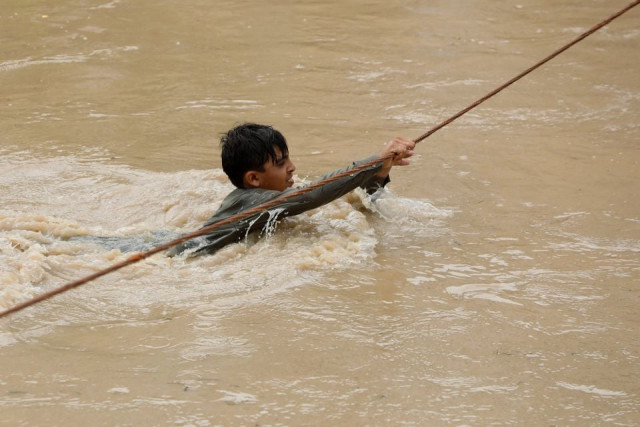More lives snuffed out as rivers ebb and flow
Around 75 people killed across country during past 24 hours

As the country continues to reel under worst floods in its memory for weeks, forecasters have warned rivers, already brimming with overwhelming water volume, will experience more flooding.
While at some rivers, the levels have receded to normal flow are on the wane, a strong flow of water coursing downstream from tributaries is threatening to burst their banks, at others.
According to estimates, the floods have affected more than 33 million people, or more than 15% of its 220 million population.
General Akhtar Nawaz, chief of the national disaster agency, said at least 72 of 160 districts had been declared calamity-hit, adding that more than two million acres of agricultural land were flooded.
According to the latest report released by the Federal Flood Commission (FFC), Indus River may experience a “very high” level of flood at Taunsa Barrage during the next 24 hours while the same was expected to continue in Kabul River in the said period.
At present, the mighty Indus River is flowing in "high flood" in Chashma-Taunsa-Guddu-Sukkur reaches and is in "medium flood" at Kalabagh and Kotri.
The flood flows in the Indus at Tarbela have receded as it is now discharging normal flows. Other main rivers of the Indus River system – Jhelum, Chenab, Ravi and Sutlej – continue to flow in normal flow conditions.
Similarly, the flood flows generated in Swat River on August 26 completely receded while the flows in River Kabul were also subsiding.
75 people killed in past 24 hours
Meanwhile, in order to avoid further untoward incidents in wake of the recent floods in the country, Federal Minister for Planning Development and Special Initiatives Professor Ahsan Iqbal on Tuesday directed National Disaster Management Authority (NDMA) to prepare comprehensive SOPs in collaboration with provincial disaster management authorities to minimise human losses.
Read Pakistan floods: South Asia's monsoon explained
The minister issued the directions while chairing a Flood Relief Committee meeting. The meeting was attended by officials of NDMA who briefed the minister on the latest flood situation in the country.
During the briefing, the NDMA informed the minister that during the past 24 hours, a heavy storm was reported in Lahore and in other parts of Punjab while less rain was reported in other parts of the country.
Similarly, it was informed that during the past 24 hours total, 75 people were killed due to the flood including 53 in Sindh, 16 in Khyber Pakhtunkhwa, five in Gilgit Baltistan and two in Balochistan.
The minister also directed the concerned stakeholders to immediately prepare maps of each affected district in order to assess the exact location and number of shelterless people.
During the briefing, the minister directed the secretary of health to hold a meeting with provinces over the latest health situation in the affected areas and then give a detailed briefing to the committee on Wednesday.
“The health authorities are directed to immediately figure out what steps have been taken so far to provide medical assistance and health cover to the affected people, particularly protection from waterborne diseases which emerge in flood-affected areas after the water recedes,” said the minister while directing the stakeholders to expedite the relief activities to provide maximum relief to the flood-affected people.


















COMMENTS
Comments are moderated and generally will be posted if they are on-topic and not abusive.
For more information, please see our Comments FAQ